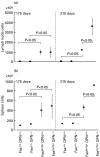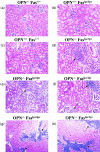Differential roles of osteopontin/Eta-1 in early and late lpr disease
- PMID: 11737079
- PMCID: PMC1906233
- DOI: 10.1046/j.1365-2249.2001.01702.x
Differential roles of osteopontin/Eta-1 in early and late lpr disease
Abstract
The cytokine osteopontin (Eta-1) leads to macrophage-dependent polyclonal B-cell activation and is induced early in autoimmune prone mice with the lpr mutation, suggesting a significant pathogenic role for this molecule. Indeed, C57BL/6-Fas(lpr/lpr) mice crossed with osteopontin(-/-) mice display delayed onset of polyclonal B-cell activation, as judged by serum immunoglobulin levels. In contrast, they are subject to normal onset, but late exacerbation of lymphoproliferation and evidence of kidney disease. These observations define two stages of Fas(lpr/lpr) disease with respect to osteopontin-dependent pathogenesis that should be taken into account in the design of therapeutic approaches to the clinical disease.
Figures




Similar articles
-
Implication of allelic polymorphism of osteopontin in the development of lupus nephritis in MRL/lpr mice.Eur J Immunol. 2005 May;35(5):1510-20. doi: 10.1002/eji.200425672. Eur J Immunol. 2005. PMID: 15832294
-
FcgammaRIIB deficiency with Fas mutation is sufficient for the development of systemic autoimmune disease.Eur J Immunol. 2003 Apr;33(4):1020-9. doi: 10.1002/eji.200323794. Eur J Immunol. 2003. PMID: 12672068
-
The central and multiple roles of B cells in lupus pathogenesis.Immunol Rev. 1999 Jun;169:107-21. doi: 10.1111/j.1600-065x.1999.tb01310.x. Immunol Rev. 1999. PMID: 10450512 Review.
-
IFN-gamma receptor signaling is essential for the initiation, acceleration, and destruction of autoimmune kidney disease in MRL-Fas(lpr) mice.J Immunol. 1998 Jul 1;161(1):494-503. J Immunol. 1998. PMID: 9647261
-
Lupus in the Fas lane?J R Coll Physicians Lond. 1995 Nov-Dec;29(6):475-8. J R Coll Physicians Lond. 1995. PMID: 8748102 Free PMC article. Review.
Cited by
-
Immunomodulatory Role of the Extracellular Matrix Within the Liver Disease Microenvironment.Front Immunol. 2020 Nov 11;11:574276. doi: 10.3389/fimmu.2020.574276. eCollection 2020. Front Immunol. 2020. PMID: 33262757 Free PMC article. Review.
-
SPP1 is a plasma biomarker associated with the dia gnosis and prediction of prognosis in sepsis.Sci Rep. 2024 Nov 8;14(1):27205. doi: 10.1038/s41598-024-78420-4. Sci Rep. 2024. PMID: 39516332 Free PMC article.
-
B cell receptor crosstalk: B cells express osteopontin through the combined action of the alternate and classical BCR signaling pathways.Mol Immunol. 2009 Feb;46(4):587-91. doi: 10.1016/j.molimm.2008.07.029. Epub 2008 Oct 25. Mol Immunol. 2009. PMID: 18952291 Free PMC article.
-
Elevated osteopontin levels in mild cognitive impairment and Alzheimer's disease.Mediators Inflamm. 2013;2013:615745. doi: 10.1155/2013/615745. Epub 2013 Mar 14. Mediators Inflamm. 2013. PMID: 23576854 Free PMC article.
-
Gottron's papules exhibit dermal accumulation of CD44 variant 7 (CD44v7) and its binding partner osteopontin: a unique molecular signature.J Invest Dermatol. 2012 Jul;132(7):1825-32. doi: 10.1038/jid.2012.54. Epub 2012 Mar 29. J Invest Dermatol. 2012. PMID: 22456539 Free PMC article.
References
-
- Lampe MA, Patarca R, Iregui MV, Cantor H. Polyclonal B cell activation by the Eta-1 cytokine and the development of systemic autoimmune disease. J Immunol. 1991;147:2902–6. - PubMed
-
- Iizuka J, Katagiri Y, Tada N, et al. Introduction of an osteopontin gene confers the increase in B1 cell population and the production of anti-DNA autoantibodies. Lab Invest. 1998;78:1523–33. - PubMed
-
- Ashkar S, Weber GF, Panoutsakopoulou V, et al. Eta-1 (osteopontin): an early component of type-1 (cell-mediated) immunity. Science. 2000;287:860–4. 10.1126/science.287.5454.860. - DOI - PubMed
-
- Weber GF, Ashkar S, Glimcher MJ, Cantor H. Receptor–ligand interaction between CD44 and osteopontin (Eta-1) Science. 1996;271:509–12. - PubMed
Publication types
MeSH terms
Substances
Grants and funding
LinkOut - more resources
Full Text Sources
Medical
Molecular Biology Databases
Research Materials
Miscellaneous

